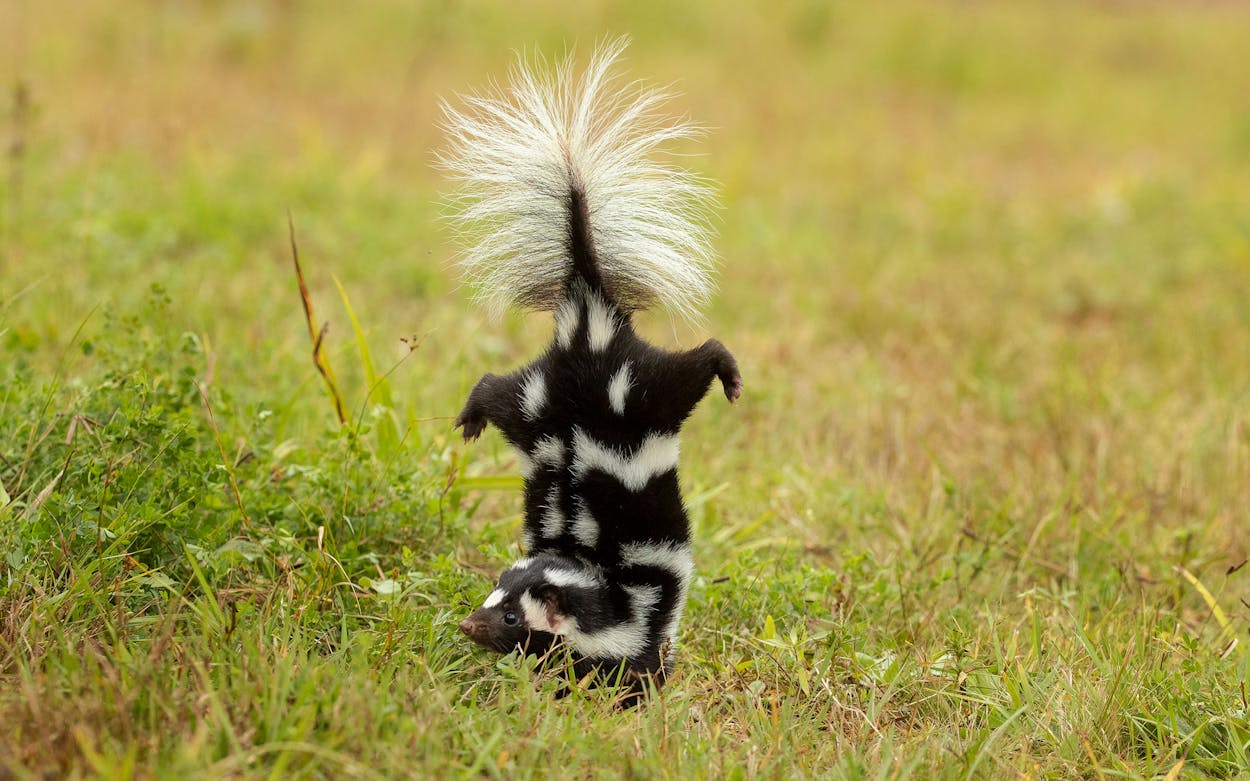As a former amateur gymnast, I know a good handstand when I see one. That’s why I can say with full confidence that no creature on God’s green earth can perform a handstand with quite as much gumption or grace as the spotted skunk. That’s right, a skunk. Ten out of ten, every time.
The pint-size mammal, which weighs between one and two pounds—about half that of its more commonly known striped relative—gets its name for its characteristic white spots. Texas is home to two of these acrobatic species. The plains spotted skunk is found in East Texas and the Panhandle, and the Western (or desert) spotted skunk roams West Texas, South Texas, and the fringes of Central Texas. Both have evolved a dazzling defense mechanism: when provoked, a spotted skunk will spring off its hind legs like a tiny Simone Biles, while its bushy tail shoots straight upward like a lightning rod. Then, with its hind paws akimbo, it can actually walk upside down on two hands.
What in the name of natural selection is the purpose of this? Some scientists, like Dana Karelus, the state mammal specialist for Texas Parks and Wildlife, suspect the wee skunk is simply trying to make itself look bigger, the better to scare off such threats as coyotes, bobcats, or humans who happen to get in its way. The handstand may also allow a skunk to aim its smelly spray a bit higher, too, marking its territory more effectively. (Pugs and other small dogs will sometimes perform the same trick for this reason.)
Robert Dowler, professor emeritus of biology at Angelo State University, in San Angelo, told me the skunk’s handstand is a kind of announcement. And its black-and-white coat, easily discernible even in the nighttime, a.k.a. the skunk’s waking hours, functions as a warning: “There are going to be consequences if you choose not to leave.”
Dowler’s been studying skunks for more than twenty years—in fact, he’s still studying them, even though he’s technically retired. When I asked him why he’d chosen skunks as his field of interest, he told me that there aren’t very many people who study the animal . . . for obvious reasons. The upside is that there’s still much to learn about them. “There’s a lot of opportunities and interesting questions that haven’t been answered about skunks,” Dowler said. The downside is—well, you know. When I asked him whether working in the field of skunks affected his personal relationships, he told me he’s been married for more than fifty years. “I guess you know it’s love.”
In fact, skunks emit their infamously malodorous yellow spray quite sparingly. “The skunks don’t want to spray,” Dowler said. “They’re trying to minimize that by giving the potential predator every chance to back off.” Hence the handstands. Meanwhile, the striped skunk, a close relative of the spotted skunk, deploys another defense mechanism: stomping its front feet on the ground to intimidate a predator, not unlike an ornery child having a tantrum—except cuter. Sometimes the performance is so dramatic, said Dowler, that the striped skunk’s hind legs lift up a little, as though attempting a handstand, though they never quite stick it.
While doing handstands may be a fairly effective defense against the spotted skunk’s animal foes, for the most part, humans have an altogether different reaction: “They’re just too cute,” Karelus said. Not even Dowler is immune to their whimsy, though in his twenty years of skunk research, he still has yet to see its acrobatic act in person. Cuteness aside, don’t be fooled by this remarkable trick. It’s not an invitation to touch them.
A skunk’s spray consists of volatile chemical compounds known as thiols, which contain sulfur. (Thiols are commonly used as additives to natural gas, so that you can smell when there’s a leak.) The spray is produced by a pair of glands—each of which has a nipple that protrudes out—on either side of the creature’s anus. (I’ll let that one sink in for a moment.) These nipples are capable of producing two different experiences of the spray: one like a fine mist; the other like a precision strike missile, capable of aiming at far distances. Spotted skunks are also the only skunks that regularly climb trees, though they typically won’t spray from up high.
Another reason a skunk may resort to spraying happens during the mating season. Female skunks who are not interested in the aggressive pursuit of a male suitor might use their spray as a last-ditch effort to ward them off. Is there any clearer message? (Read: she’s just not that into you.) Likewise, males vying for the same female might be inclined to spray each other.
One of the questions Dowler often gets is whether skunks ever run out of the stuff. It can happen, but rarely, he said, though it’s not unusual for a skunk to spray more than once. “They can certainly fire repeatedly,” he said.
The key difference between Texas’s two spotted skunk species is their breeding patterns: whereas the plains spotted skunk breeds in late winter or early spring and bears its offspring—litters of three to four baby skunks—in the spring months, the desert spotted skunk actually breeds in the fall. Then, through a process known as delayed implantation, the embryo goes into a suspended state during the winter months. Come spring, the embryo implants and grows into a baby skunk.
But you’d be lucky to spot either one out in the wild. The species Texans are most likely to see is the striped skunk, which is prevalent across the state. (We also have two other species: the hog-nosed, found in the Trans-Pecos region and South Texas, and the hooded skunk, found only in Big Bend.) The spotted skunk is an elusive genus; they avoid open spaces that would expose them to owls and other predators, preferring instead to inhabit thick shrubbery. You’ll rarely find them as roadkill, as they generally avoid crossing roads. When Dowler and his students studied the plains spotted skunk in the Katy Prairie, part of the Western Gulf coastal grasslands, they discovered the animals like to curl up for a siesta beneath dewberry bushes and McCartney rose bushes, both of which have thorns to deter predators, while the dewberries also serve as a good source of food.
Habitat loss, especially the Houston sprawl, is another reason why they’re such a rare sight; the plains spotted skunk, in particular, is in trouble. Last year, the U.S. Fish and Wildlife Service considered placing the animal on its endangered species list. It didn’t make the cut, but Texas Parks and Wildlife considers the species one of greatest conservation need. Though some may consider them a nuisance, in fact, skunks play a crucial role in the food chain, feeding on mice, snakes, insects and insect larvae, keeping their populations controlled. “They’re a very important part of maintaining the balance,” said Dowler.
Fortunately, there’s a way that folks can help. “Citizen science can be really helpful,” said Karelus. Because spotted skunk sightings are so rare and often occur unexpectedly, it helps to document when they do occur. Through an application called iNaturalist, anyone can log a sighting. “That way we can use it to better understand where there might be a population or where we might go to look for a future study,” she said. So the next time you see a skunk, back away carefully, then take a photo to ID later. You’ll have done your part to help these little acrobats keep stinking up our fair state.
- More About:
- Critters








